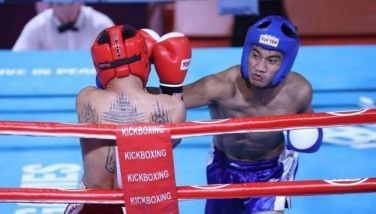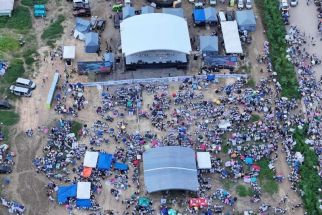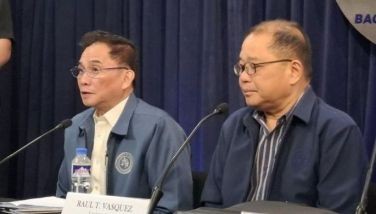Are the military and police, instead, the ones being harassed?
August 28, 2006 | 12:00am
The above headline voices an almost sacrilegious thought. The statistic of 741 militants, activists, church workers, labor leaders and journalists having been assassinated in this violence-riddled country has been bandied about so often, not only locally but in the foreign media that our archipelago is being made to appear worldwide like a slaughterhouse.
Yet, as I inquired in yesterday’s column, how did we come about with this grim and startingly impressive total of politically and ideologically-motivated murders?
Let’s have a roll-call, please, and in the interest of truth get our facts straight.
True enough, there have been too many killings in this land which has a surfeit of guns and goons – some of them in the military and the police. Yet there’s obviously exaggeration somewhere, and even a normally vigilant media as well as a scatter of NGOs have swallowed the pack of lies buried under a mountain of facts – almost without question.
At a meeting late Friday night, I asked Police Deputy Director General Avelino "Sonny" Razon, who’s in charge of administration and special police investigations to clarify the situation. He gave me the following Update on "Task Force USIG", which is conducting the PNP’s inquiry into the assassinations of "party list/militant members, media men and other high-risk personalities over the past five years."
In the Razon report, the number of "militants" slain between 2001 and 2006 came to 110 incidents.
According to USIG, 11 of the killings were perpetrated by the Communist Party of the Philippines and its armed element, the New People’s Army (CPP/NPA). In this category, 11 cases have been filed, one suspect has been arrested, and 11 "suspects" are still at large.
Next, 12 were believed to have been perpetrated by the CPP/NPA (with 12 suspects at large); six were killed by the military or its militia supporters, i.e. by two soldiers, one CAFGU, and three military "assets." Four cases have been filed, and one suspect arrested.
Ten killings were also directly linked to the military (ten suspects remain at large); one was killed by police personnel, with a case already filed and the suspect arrested. Razon pointed out that the police figures almost jibed with the figure announced by Amnesty International (114 militants killed) when the London-based human rights body scored the Philippines for its long string of extrajudicial killings.
According to the Task Force USIG report, twenty-six mediamen or journalists were slain between 2001 and 2006.
Two were admittedly slain by military elements (two cases filed, one suspect arrested); three were killed by police personnel (three cases have been filed, two suspects arrested, and one convicted: the suspects hit the journalists allegedly for their exposés of scandal and illegal gambling); four were killed by government officials (the cases involved two mayors and two barangay chairmen. Four cases have been filed and four suspects have surrendered).
The Police report claimed that 81 percent of the murders of journalists were "solved". However, only one of the suspects has as yet been convicted. Twenty-one cases have been filed in court, while five are still under investigation.
Anyway, that’s the PNP side of the story.
General Razon, by the way, played a major role in the uncovering of the contents of the captured laptop of al-Qaeda terrorist Ramzi Yousef which was seized in 1993 when the terrorist’s Manila apartment caught fire owing to the chemicals being "brewed" by him and his confederate Murad.
In the beginning, none of the police agencies "informed" by the PNP – Interpol, Scotland Yard, and intelligence services in neighboring countries – knew the identity of the mysterious bomb-maker, who had registered when he rented the apartment as a "Moroccan" engineer. The US Federal Bureau of Investigation (FBI), however, looked more closely since the escaped bomb-maker, as indeed he was, might have been the man who planted a bomb on a Philippine Airlines (PAL) plane bound for Tokyo a month earlier.
A partial fingerprint found in the half-burned apartment matched that of Yousef’s stored in the Interpol computers – and they had the identity of the culprit! The PNP turned the suspect’s captured laptop over to FBI inspection, and Mary Horvath, an FBI computer expert, who was rushed to Manila made three back-up copies of the laptop’s hard-drive. That’s when they finally, after much effort at decoding its contents, discovered the "Bojinka Plot" to hijack American airliners flying across the Pacific.
Incidentally, Yousef’s repeated visits to the Philippines serve to confirm al-Qaeda’s interest in making this country one of its key "terror" bases under the supervision of one of its spin-offs, the murderous Jemaah Islamiya which has been establishing itself in Sulu and mainland Mindanao.
In 1991 Osama bin Laden had dispatched Yousef to Basilan to train members of the Abu Sayyaf in sophisticated bomb-making techniques. According to journalist Simon Reeve in his landmark book (Bost, 1999) published long before 9/11 – namely "The New Jackals," – Yousef flew from his home in Pakistan to Malaysia, then traveled by boat to the city of Zamboanga, then took a ferry (pump-boat) for the 90-minute crossing to the Abu Sayyaf’s lair in Basilan.
Yousef already knew the ASG head, Abdurajak Abubakar Janjalani (the current chieftain’s now slain older brother). They were said to have met in the northern Pakistani town of Peshawar, on the frontier of the Pashtun tribal territories and Afghanistan. The two were training to fight the Soviets who were occupying Afghanistan. The young jihadis had immediately struck up a friendship. Reeve says that an Islamic missionary had earlier encouraged Janjalani to study Islamic jurisprudence in Saudi Arabia (the financier of the madrassas or Koranic schools around the world which preach the Wahhabi fundamentalist doctrine). Janjalani, returning from Saudi Arabia had spent years fighting the Russians in Afghanistan, along with 200 other Moros from the Philippines.
These Afghan-war trained Muslims were to form the core of Islamic fundamentalist insurgency in our country. In any event, Ramzi Yousef spent several weeks in Basilan, then transferred his activities to Metro Manila.
The elder Janjalani was later slain in an encounter with PNP units in Basilan.
Bin Laden’s brother-in-law Khalifa also spent a couple of years in Mindanao, establishing an Islamic "charity," and marrying – among his wives – a local girl.
It’s no wonder the Bali-bombing mastermind Dulmatin and three other JI terrorists are in Mindanao, joining Khadaffy Janjalani in working to set up a terrorist base. However, their aim has been frustrated by a determined offensive which has been in high gear for three weeks.
The armed forces are determined to get Janjalani and company, particularly Dulmatin who has a bounty of $10 million on his head.
Armed Forces Chief of Staff, now a full four-star General, Hermogenes C. Esperon Jr. expressed surprise, when he met with this writer Thursday at how the militant lawyers and human rights activists of Karapatan are industriously sueing military officers and police officers in various courts, including the Supreme Court. Surely the militant Karapatan is not, as some of military allege, a front organization for the CPP/NPA.
There are two interesting cases now pending in the Supreme Court. One under the category of SP PROC No. 173576, filed by three petitioners, is a habeas corpus case versus PNP Director General Oscar Calderon, Gen. Esperon (as AFP Chief of Staff); Commodore Leonardo C. Calderon, Jr., (ISAFP Chief) and other ranking police officers, plus Defense Secretary Avelino Cruz, National Security Chairman Norberto Gonzales, "and all persons acting on their behalf" to produce: Prudencio Calubid, Celina Palma, Ariel Beloy and Gloria Socco.
Among the allegations in the petition is the assertion that "there have been recorded by Karapatan, a Human Rights group, some 175 abductions and disappearances since the start of the repressive Arroyo Regime."
The petition further alleged that on June 27, 2006, an abductee named Antonio Laono was boxed and mistreated by the military, to force him "to admit that he was an NPA member."
Later, "he and Prudencio Calubid were taken back to a vehicle and they started to fear they were going to be killed. The petition averred they stopped at a certain place and the blindfolded Laono was made to go out of the vehicle . . . then "he heard Prudencio Calubid shout, ‘Aray, Entoy balisong’ and he could hear Calubid slump and crumple on the vehicle’s floor."
In the confusion of another encounter, Laono allegedly was able to run off, jump over a wall and get away.
Now, the habeas corpus petition demands that the "body" dead or alive of course, of Calubid and four others be produced, or else.
Esperon, when he was served notice of the case, was surprised. Careful not to comment on the merits of the case, which is sub judice, he exclaimed to me: "By gosh, if we had captured or killed Prudencio Calubid, we wouldn’t have kept it secret. We would have issued a big press release about it, or held a press conference to announce it to the media. For Calubid is one of the NPA’s biggest fish – indeed, he is the suspected head of the National Military Staff of the CPP/NPA – in short, their military commander-in-chief!"
In another case of habeas corpus before the Supreme Court, the petitioners are asking for Leopoldo Magalang Ancheta to also be "produced."
Esperon and his staff officers told me, "We don’t have him either. But we’d have been overjoyed to announce it if we did – Ancheta is one of the highest-ranking CPP/NPA, in fact, we suspect he’s a member of the Central Committee."
Several cases filed against military officers, apparently, keep them running from one court venue to another. Is this another form of guerrilla war? Perhaps, the idea is to exhaust our ranking armed forces officers, and zap them of their morale, and will to fight.
"Åll things are fair in love and war," an old saying of our school days went. Nowadays, the parliamentary struggle may bear this out.
Yet, as I inquired in yesterday’s column, how did we come about with this grim and startingly impressive total of politically and ideologically-motivated murders?
Let’s have a roll-call, please, and in the interest of truth get our facts straight.
True enough, there have been too many killings in this land which has a surfeit of guns and goons – some of them in the military and the police. Yet there’s obviously exaggeration somewhere, and even a normally vigilant media as well as a scatter of NGOs have swallowed the pack of lies buried under a mountain of facts – almost without question.
At a meeting late Friday night, I asked Police Deputy Director General Avelino "Sonny" Razon, who’s in charge of administration and special police investigations to clarify the situation. He gave me the following Update on "Task Force USIG", which is conducting the PNP’s inquiry into the assassinations of "party list/militant members, media men and other high-risk personalities over the past five years."
In the Razon report, the number of "militants" slain between 2001 and 2006 came to 110 incidents.
According to USIG, 11 of the killings were perpetrated by the Communist Party of the Philippines and its armed element, the New People’s Army (CPP/NPA). In this category, 11 cases have been filed, one suspect has been arrested, and 11 "suspects" are still at large.
Next, 12 were believed to have been perpetrated by the CPP/NPA (with 12 suspects at large); six were killed by the military or its militia supporters, i.e. by two soldiers, one CAFGU, and three military "assets." Four cases have been filed, and one suspect arrested.
Ten killings were also directly linked to the military (ten suspects remain at large); one was killed by police personnel, with a case already filed and the suspect arrested. Razon pointed out that the police figures almost jibed with the figure announced by Amnesty International (114 militants killed) when the London-based human rights body scored the Philippines for its long string of extrajudicial killings.
According to the Task Force USIG report, twenty-six mediamen or journalists were slain between 2001 and 2006.
Two were admittedly slain by military elements (two cases filed, one suspect arrested); three were killed by police personnel (three cases have been filed, two suspects arrested, and one convicted: the suspects hit the journalists allegedly for their exposés of scandal and illegal gambling); four were killed by government officials (the cases involved two mayors and two barangay chairmen. Four cases have been filed and four suspects have surrendered).
The Police report claimed that 81 percent of the murders of journalists were "solved". However, only one of the suspects has as yet been convicted. Twenty-one cases have been filed in court, while five are still under investigation.
Anyway, that’s the PNP side of the story.
General Razon, by the way, played a major role in the uncovering of the contents of the captured laptop of al-Qaeda terrorist Ramzi Yousef which was seized in 1993 when the terrorist’s Manila apartment caught fire owing to the chemicals being "brewed" by him and his confederate Murad.
In the beginning, none of the police agencies "informed" by the PNP – Interpol, Scotland Yard, and intelligence services in neighboring countries – knew the identity of the mysterious bomb-maker, who had registered when he rented the apartment as a "Moroccan" engineer. The US Federal Bureau of Investigation (FBI), however, looked more closely since the escaped bomb-maker, as indeed he was, might have been the man who planted a bomb on a Philippine Airlines (PAL) plane bound for Tokyo a month earlier.
A partial fingerprint found in the half-burned apartment matched that of Yousef’s stored in the Interpol computers – and they had the identity of the culprit! The PNP turned the suspect’s captured laptop over to FBI inspection, and Mary Horvath, an FBI computer expert, who was rushed to Manila made three back-up copies of the laptop’s hard-drive. That’s when they finally, after much effort at decoding its contents, discovered the "Bojinka Plot" to hijack American airliners flying across the Pacific.
Incidentally, Yousef’s repeated visits to the Philippines serve to confirm al-Qaeda’s interest in making this country one of its key "terror" bases under the supervision of one of its spin-offs, the murderous Jemaah Islamiya which has been establishing itself in Sulu and mainland Mindanao.
In 1991 Osama bin Laden had dispatched Yousef to Basilan to train members of the Abu Sayyaf in sophisticated bomb-making techniques. According to journalist Simon Reeve in his landmark book (Bost, 1999) published long before 9/11 – namely "The New Jackals," – Yousef flew from his home in Pakistan to Malaysia, then traveled by boat to the city of Zamboanga, then took a ferry (pump-boat) for the 90-minute crossing to the Abu Sayyaf’s lair in Basilan.
Yousef already knew the ASG head, Abdurajak Abubakar Janjalani (the current chieftain’s now slain older brother). They were said to have met in the northern Pakistani town of Peshawar, on the frontier of the Pashtun tribal territories and Afghanistan. The two were training to fight the Soviets who were occupying Afghanistan. The young jihadis had immediately struck up a friendship. Reeve says that an Islamic missionary had earlier encouraged Janjalani to study Islamic jurisprudence in Saudi Arabia (the financier of the madrassas or Koranic schools around the world which preach the Wahhabi fundamentalist doctrine). Janjalani, returning from Saudi Arabia had spent years fighting the Russians in Afghanistan, along with 200 other Moros from the Philippines.
These Afghan-war trained Muslims were to form the core of Islamic fundamentalist insurgency in our country. In any event, Ramzi Yousef spent several weeks in Basilan, then transferred his activities to Metro Manila.
The elder Janjalani was later slain in an encounter with PNP units in Basilan.
Bin Laden’s brother-in-law Khalifa also spent a couple of years in Mindanao, establishing an Islamic "charity," and marrying – among his wives – a local girl.
It’s no wonder the Bali-bombing mastermind Dulmatin and three other JI terrorists are in Mindanao, joining Khadaffy Janjalani in working to set up a terrorist base. However, their aim has been frustrated by a determined offensive which has been in high gear for three weeks.
The armed forces are determined to get Janjalani and company, particularly Dulmatin who has a bounty of $10 million on his head.
There are two interesting cases now pending in the Supreme Court. One under the category of SP PROC No. 173576, filed by three petitioners, is a habeas corpus case versus PNP Director General Oscar Calderon, Gen. Esperon (as AFP Chief of Staff); Commodore Leonardo C. Calderon, Jr., (ISAFP Chief) and other ranking police officers, plus Defense Secretary Avelino Cruz, National Security Chairman Norberto Gonzales, "and all persons acting on their behalf" to produce: Prudencio Calubid, Celina Palma, Ariel Beloy and Gloria Socco.
Among the allegations in the petition is the assertion that "there have been recorded by Karapatan, a Human Rights group, some 175 abductions and disappearances since the start of the repressive Arroyo Regime."
The petition further alleged that on June 27, 2006, an abductee named Antonio Laono was boxed and mistreated by the military, to force him "to admit that he was an NPA member."
Later, "he and Prudencio Calubid were taken back to a vehicle and they started to fear they were going to be killed. The petition averred they stopped at a certain place and the blindfolded Laono was made to go out of the vehicle . . . then "he heard Prudencio Calubid shout, ‘Aray, Entoy balisong’ and he could hear Calubid slump and crumple on the vehicle’s floor."
In the confusion of another encounter, Laono allegedly was able to run off, jump over a wall and get away.
Now, the habeas corpus petition demands that the "body" dead or alive of course, of Calubid and four others be produced, or else.
Esperon, when he was served notice of the case, was surprised. Careful not to comment on the merits of the case, which is sub judice, he exclaimed to me: "By gosh, if we had captured or killed Prudencio Calubid, we wouldn’t have kept it secret. We would have issued a big press release about it, or held a press conference to announce it to the media. For Calubid is one of the NPA’s biggest fish – indeed, he is the suspected head of the National Military Staff of the CPP/NPA – in short, their military commander-in-chief!"
In another case of habeas corpus before the Supreme Court, the petitioners are asking for Leopoldo Magalang Ancheta to also be "produced."
Esperon and his staff officers told me, "We don’t have him either. But we’d have been overjoyed to announce it if we did – Ancheta is one of the highest-ranking CPP/NPA, in fact, we suspect he’s a member of the Central Committee."
Several cases filed against military officers, apparently, keep them running from one court venue to another. Is this another form of guerrilla war? Perhaps, the idea is to exhaust our ranking armed forces officers, and zap them of their morale, and will to fight.
"Åll things are fair in love and war," an old saying of our school days went. Nowadays, the parliamentary struggle may bear this out.
BrandSpace Articles
<
>
- Latest
- Trending
Trending
Latest





























